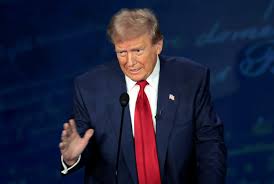President Donald Trump said Wednesday he was pausing higher targeted tariffs for 90 days for most countries, a stunning reversal in his trade war that has sent markets reeling.
In a post on X just before 1:30 p.m., Trump wrote that he came to the decision because more than 75 trading partners did not retaliate and have reached out to the U.S. to “discuss” some of the issues he had raised.
But the pause didn’t apply to China, which has retaliated — with 84% hikes. Trump instead raised duties for that country to 125%, effective immediately.
“Based on the lack of respect that China has shown to the World’s Markets, I am hereby raising the Tariff charged to China by the United States of America to 125%, effective immediately,” he wrote. “At some point, hopefully in the near future, China will realize that the days of ripping off the U.S.A., and other Countries, is no longer sustainable or acceptable.”
But the trade war isn’t exactly over, and the pause didn’t return the world back to the time before Trump touched off the global instability; a 10% across-the-board duty will remain in place — including for some products from Canada and Mexico.
It was not immediately clear which countries would be covered by the pause; the White House would not say. Earlier Wednesday the E.U. voted to impose fresh retaliatory duties, but those aren’t set to take effect until next week.
And separate tariffs on imported autos, steel and aluminum will remain in place, Treasury Secretary Scott Bessent later said — while planned tariffs on items like lumber and pharmaceuticals are still on.
It’s not clear what prompted Trump to change his mind — he appeared to dig in just hours earlier, telling Americans “BE COOL” in a Truth Social post, and he suggested not that long ago the tariffs could be permanent.
“I did a 90 day pause for the people that didn’t retaliate, because I told them, ‘If you retaliate, we’re going to double it.’” Trump said Wednesday. “And that’s what I did with China, because they did retaliate. So we’ll see how it all works out. I think it’s going to work out amazing.”
But markets have been in stunning turmoil -— major stock indexes shed trillions of dollars in value, while alarming signals from the bond market set Wall Street on edge.
When a false-at-the-time headline suggesting Trump would take a 90-day pause shot around the internet on Monday, markets briefly surged. And a growing chorus of business leaders and Trump’s allies have come out publicly against the tariffs, including Tesla CEO Elon Musk.
Markets soared on the surprising news Wednesday, with the S&P 500 climbing more than 9%, the tech-heavy Nasdaq closed up more than 12%, and the Dow Jones Industrial Average ended nearly 3,000 points higher. Among the big gainers: Tesla stock was up 22%.
Borrowing costs, which had surged early Wednesday as the tariffs took effect, also eased slightly, though not substantially as some investors may fear a lingering fallout from the tariffs episode.
Borrowing costs — which had surged early Wednesday as the tariffs took effect — also eased slightly, though not substantially as some investors may fear a lingering fallout.
Trump has been talking about tariffs as the solution for U.S. economic problems since before he became president; he branded April 2 — when he unveiled the plan — “liberation day,” saying it would end decades of the U.S. being “looted, pillaged, raped and plundered” by other countries.
The global markets recoiled, and last week $6.6 trillion alone was wiped out. Yet Trump and his allies had until Wednesday doubled down, arguing tariffs were necessary to return manufacturing to the U.S. and fill the nation’s coffers with trillions of dollars in revenue that could be used to pay down debt or offset tax cuts.
It’s not clear how the White House expects the policies to fuel big gains now. With the lower 10% tariff rate left in place there will be less incentive for companies to relocate production to the U.S. and less revenue being generated.
After the news, the Treasury secretary sought to make the about-face into a negotiating tactic, insisting it was a way to scare countries into coming to the negotiating table by demonstrating how high the U.S. was going to go.
“President Trump created maximum negotiating leverage for himself,” Bessent said.
But it’s unclear how successful the U.S. will be at negotiating new trade agreements with other countries given Trump’s on-again off-again threats over the past several months. Previously, Trump had threatened sweeping tariffs on all imports from Mexico and Canada before walking most of them back.
And while markets surged higher Wednesday following Trump’s pause, economic uncertainty remains over what will come next in the U.S. trade war with China, which exports more than $400 billion worth of goods to the U.S. each year.
Under Trump’s new tariffs, the cost for U.S. companies importing goods from China has more than doubled. Those products include everything from toys and sneakers to televisions and iPhones.
U.S. companies exporting their products to China are also caught up in the fray after China increased its tariffs on American goods like agriculture products and machinery. But the White house is downplaying that risk.
“What I am certain of is that what China is doing will affect their economy much more than ours because they have an export-driven, flood the world with cheap exports model,” Bessent said.
Commerce Secretary Howard Lutnick posted to X that he sat with Trump as he posted the initial message, adding: “The world is ready to work with President Trump to fix global trade, and China has chosen the opposite direction.”



